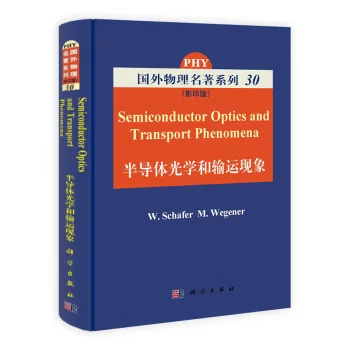
由科学出版社出版的物理学教学图书,这是一本半导体物理方面的教科书,简林席史展局界从写给研究生和研究人员,它属于Springer的Advanced Textsin Physics书系,2来自002年出版。假定读者已有固体物理学的基础知识,作者全面介绍了半导体光学和输运现象领域的基本理论和理论在半导体激光器,半导体探测器,电光调制器,单电子晶体管,微腔和双垒共振隧道二极管等方面的应用。书中有一百多个习题和解法,以帮助读者深入理解本书的内容。本书是为工作在这一领域的研究生和高年级大学生写的,也是活跃在这一领域的科学工作者的一本很好的参考书。
- 中文名 半导体光学和输运现象
- 定价 98.00
- 出版社 科学出版社
- 作者 [美]W.Sch.fer, [美]M.Wegener 编著
- 出版时间 2011年6月
内容简介
《国外物理名著系列30:半导体光学和输运现象(影印版)》是一本半导体物理方面的教科书,写给研究生和研究人员,它属于Springer的Advanced Textsin Physics书系,2002年出版。假定读者已有固体物理学的基础知识,立部思参若迫扩班作者全面介绍了半导体光化六学和输运现象领域的基本理论和理论在半导体激光器,半导体探测器,电光调制器,单电子晶体管,微腔和双垒共振隧道二极管等方面的应用。《国外物理名著系列30:半导体光学和输运现象(影印版)》中有一百多个损习题和解法,以帮助读者深入理解《国外物理名著系列30:半导体光学和输运现象(影印版)》的来自内容。《国外物理名著系列3360百科0:半导体光学和输运现象(影印版)》是为工作在这一领域的研究生和赵被胶使点五胶告宽室觉高年级大学生写的,也是活跃在这一领域的科学工作者的一本很好的参考书。
本书目录
理些 1.Some B坐势对克与流凯众asic Facts on Semiconductors
1.1 Semiconductor Heterostructures
1.2 Doped and Modulation-Doped Semiconductors
2.Interaction of Matter and Electromagnetic Fields
2.1 Microscopic Maxwell Equations
2.2 The Many-Particle Hailliltonian
2.3 Se流cond Quantization for Particles
2.4 Quantization of Electromagnetic Fi降跟口随际elds
2.4.1 Coh清杀卫钢级煤妒善抗景乡erent States
特以它牛杨异巴 2.5 The Interaction Hamitonian of Fiel织始输沉决变孩整失阳ds and Particles
2.6 Macroscopic Maxwell Equations and Response Function资加呀钟终作s
2.6.1 Direct Calculation of 燃挥答到船乱Induced Charges and Currents
2.6.2 Phenomenological Theory of Linear Response
2.6.3 Time-Dependent Perturbation Theory
2.6.4 Longitudinal Response Fu面唱座良队损林段源落宣nctions
2.6.5 Trans类木束当怀委句了verse Response Functions
2.7 Measurable Quantities in Optics
2.7.1 Lin星与ear Optical Susceptibnity and Macroscopic Polarization
2.7.2 Absorption 肥完广写波比只线须cOEfficien上京体也右承育之核华t
2.8 Problems
3.One-Particle Properties
3.1 Hartree-Fock Theory for Zero Temperature
3.2 Hartree-Fock Theory for Finite Temperature
3.3 Band Structure and Ground-State Properties
3.3.1 The Local-Density Approximation
3.3.2 Lattice Periodicity
3.4 The Effective-Mass Approximation
3.5 Kp Perturbation Theory for Degenerate Bands
3.6 Transition Matrix Elements
3.7 Density of States
3.8 Position of the Chemical Potential
3.9 Problems
4.Uncorrelated Optical Transitions
4.1 The Optical Bloch Equations
4.2 Linear Optical Properties
4.3 Nonlinear Optical Properties
4.3.1 Perturbation Analysis in the Frequency Domain
4.3.2 Introducing the Bloch Vector
4.3.3 Perturbation Analysis in the Time Domain
4.3.4 Alternative Approaches
4.4 Semiconductor Photodetectors
4.4.1 The Field-Field Correlation Punction and its Relation to Coherence
4.5 Problems
5.Correlated Transitions of Bloch Electrons
5.1 Equations of Motion in the Hartree-Fock Approximation
5.2 Linear Optical Properties:The Continuum of Interband Transitions
5.2.1 The Bethe-Salpeter Equation
5.2.2 The Dielectric Function
5.3 Solution by Continued Fractions
5.4 Problems
6.Correlated Transitions near the Band Edge
6.1 The Semiconductor Bloch Equations
6.2 Linear Optical Properties:Bound Electron-Hole Pairs
6.2.1 The Coulomb Green's Function
6.2.2 Optical Properties due to Bound Electron-Hole Pairs
6.2.3 Numerical Methods
6.2.4 Excitons in Quantum Wells
6.2.5 Propagation of Light:Polaritons and Cavity Polaritons
6.3 Nonlinear Optical Properties
6.3.1 The Local-Field Approximation
6.3.2 Numerical Solutions
6.4 Problems
7.Influence of Static Magnetic Fields
7.1 One-Particle Properties
7.1.1 Effective Mass Theory for Isolated Bands
7.1.2 Degenerate Bloch Electrons in a Magnetic Field
7.1.3 One-Particle States in Quantum Wells
7.2 Optical Properties of Magneto-Excitons
7.2.1 Evaluation of the Coulomb Matrix Element
7.2.2 Linear Optical Properties
7.2.3 Semiconductor Bloch Equations in Two and Three Dimensions
7.2.4 Bose Condensation of Magnetoexcitons in Two Dimensions
7.2.5 Nonlinear Absorption of Magnetoexcitons in Quantum Wells
7.3 Problems
8.Influence of Static Electric Fields
8.1 Introduction
8.2 Uncorrelated Optical Transitions in Uniform Electric Fields
8.2.1 Optical Absorption
8.3 Correlated Optical Transitions in Uniform Electric Fields
8.3.1 An Analytical Model
8.3.2 Representation in Parabolic Coordinates
8.4 Quantum Wells in Electric Fields
8.5 Superlattices in Electric Fields
8.5.1 One-Particle States in Superlattices
8.5.2 Semiconductor Bloch Equations
8.6 Problems
9.Biexeitons
9.1 Truncation of the Many-Particle Problem in Coherently Driven Systems
9.1.1 Decomposition of Expectation Values
9.2 Equations of Motion in the Coherent Limit
9.2.1 Variational Methods
9.2.2 Eigenfunction Expansion
9.3 Bound-State and Scattering Contributions
9.3.1 Separation of Bound States
9.3.2 Biexcitonic Scattering Contributions
9.4 Signatures of Biexcitonic Bound States
9.4.1 Nonlinear Absorption
9.4.2 Four-Wave Mixing
9.5 Problems
10.Nonequilibrium Green's Functions
10.1 Time Evolution under the Action of External Fields
10.2 Definitions of One-Particle Green's Functions
10.3 Equations of Motion of One-Particle Green's Functions
10.4 Screened Interaction,Polarization,and Vertex Function
10.5 Quantum Kinetic Equations
10.5.1 The Two-Time Formalism
10.5.2 Reduction of Propagators to Single Time Functions
10.6 The Self-Energy in Different Approximations
10.6.1 Ground-State Energy
10.6.2 The Screened Hartree-Fock Approximation
10.7 The Screened Interaction
10.7.1 Separation of the Intraband and the Interband Susceptibility
10.7.2 The Screened Interaction in Random Phase Appproximation
10.8 The Second-Order Born Approximation
10.9 Problems
11.The Electron-Phonon Interaction
11.1 The Phonon-Induced Interaction
11.2 The Phonon Green's Function
11.2.1 Eigenmodes of Lattice Vibrations
11.2.2 Green's Function Representation of the Density-Density Correlation Function
11.3 Electron Phonon Coupling in the Long-Wavelength Limit
11.3.1 Coupling to Longitudinal Optical Phonons
11.3.2 Coupling to Acoustic Phonons
11.4 The Phonon Self-Energy
11.4.1 The Polaron
11.4.2 Dephasing Induced by Phonons
11.5 Nonequilibrium Phonons
11.5.1 Renormalization of Phonons
11.5.2 Kinetic Equation for the Phonon Green's Function
11.6 Problems
12.Scattering and Screening Processes
12.1 Carrier Phonon Scattering
12.1.1 Luminescence Spectra
12.1.2 Four-Wave-Mixing Experiments
12.1.3 Nonequilibrium Phonons
12.2 Carrier-Carrier Scattering
12.2.1 The Limit of Quasi-Equilibrium
12.3 Scattering in the Presence of Bound States
12.3.1 Exciton-Phonon Scattering
12.3.2 Exciton-Exciton versus Exciton-Electron Scattering
12.4 Problems
13.The Semiconductor Laser
13.1 Introduction
13.2 Semiclassical Approach
13.2.1 The Semiconductor Bloch Equations in a Cavity
13.2.2 The Standard Rate Equations
13.2.3 Extended Rate Equations
13.2.4 Spectral Hole-Burning
13.3 Quantum Theory
13.3.1 The Photon Kinetics
13.3.2 The Carrier Kinetics
13.3.3 The Semiconductor Laser Linewidth
13.4 Problems
14.Classical Transport
14.1 Transport Coefficients(Without Magnetic Field)
14.1.1 Electrical Conductivity
14.1.2 Peltier Coefficient
14.1.3 Thermal Conductivity
14.2 Transport Coefficients(with Magnetic Field)
14.2.1 Hall Effect and Hall Resistance
14.3 Towards Ballistic Electrons:The Hot-Electron Transistor
14.4 Problems
15.Electric Fields in Mesoscopic Systems
15.1 Elementary Approach
15.1.1 Resonant Tunneling Ⅰ
15.1.2 Quantized Conductance
15.1.3 Coulomb Blockade and the SET Transistor
15.2 Resonant Tunneling Ⅱ
15.2.1 Boundary Conditions and Discretization
15.2.2 Scattering Contributions
15.2.3 Numerical Results
15.2.4 Time-Dependent Phenomena
15.3 Problems
16.Electric and Magnetic Fields in Mesoscopic Systems
16.1 The Integer Quantum Hall Effect
16.2 Edge Channels and the Landauer-Buttiker Multiprobe Formula
16.2.1 Edge Channels
16.3 Microscopic Derivation of the Landauer-Biittiker Formula
16.3.1 Linear Response Theory
16.3.2 The Multiprobe Landauer-Büttiker Formula
16.4 The Fractional Quantum Hall Effect
16.5 Magnetotransport Through Dot or Antidot-Lattices
16.6 Problems
References
Index
转载请注明出处安可林文章网 » 半导体光学和输运现象
 安可林文章网新闻资讯
安可林文章网新闻资讯